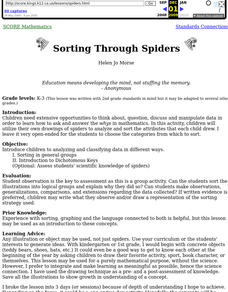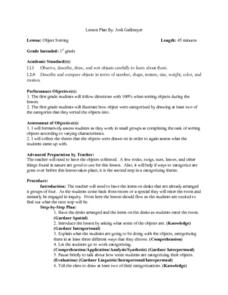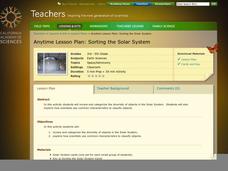Florida Center for Reading Research
Phonics: Letter-Sound Correspondence, Letter-Sound Folder Sort
Practice letter-sound correspondence using an activity that challenges pupils to sort images based on their final sounds. Pairs choose four final sounds to place in an open file folder, take turns selecting image cards, pronouncing the...
Florida Center for Reading Research
Comprehension: Text Analysis, Persuade, Inform, and Entertain Sort
Why do authors write? Practice determining the author's purpose with a categorizing activity. Learners sort twelve short passages into three categories: persuade, inform, and entertain.
Curated OER
Phonological Awareness, Phoneme Manipulating, Phoneme Position Sort
Scholars make new words out of old ones by manipulating phonemes. Pupils mix and match initial, medial, and final phonemes to change words like cap into cup or head into bed.
Serendip
Mitosis and Meiosis Card Sort
Cells divide by one of two processes, either mitosis or meiosis. Scholars sort cards into two sets, one representing each type of cell division. Then, they sequence the cards demonstrating an understanding of the movement of chromosomes.
Curated OER
Sorting Fish by Number
Go fish! Kindergartners match numbers between fishermen and the fish they're catching. Once kids finish their number practice, they can color the page. For extra fun, bring in plastic fish with numbers, and assign numbers to kids to...
Kindergarten Kindergarten
Living and Non-Living Sort
What do an ice cream cone, bicycle, and alarm clock all have in common? That's exactly what young scientists will find out as sort these pictures and learn about the differences between living and non-living things.
Curated OER
Reproduction, Day 2: Pregnancy
Nearly all students have seen pregnant women and may have questions about human development. Intended for secondary students with mild to moderate mental disabilities, this lesson defines the process of pregnancy in a developmentally...
Curated OER
Desert Animal Sorting
What makes certain animals better suited for desert life than others? Explore the differences between desert and non-desert animals with this picture sorting activity. Be sure to print the worksheet in color so students can observe and...
Curated OER
Sorting
Students examine Library organization. In this logic instructional activity, students watch a Between the Lions episode and consider how the library has been organized. Students each list their 3 favorite book titles and how they would...
Curated OER
Sorting and Classifying Concrete Objects by Varying Attributes
First graders examine how to sort concrete objects by their attributes. In this sorting instructional activity, 1st graders listen to Gray Rabbit's Odd One Out by Alan Baker, and discuss the actions of the main character. They practice...
Curated OER
Sorting Living and Nonliving Objects
Third graders sort and classify objects. In this sorting lesson plan, 3rd graders sort small objects such as cereal or candy. Then, students classify and sort objects that are living or nonliving.
Curated OER
Sorting Through Spiders
Students utilize their own drawings of spiders to analyze and sort the attributes that each student drew.
Curated OER
Object Sorting
First graders follow directions when sorting objects. They illustrate how objects are categorized by drawing at least two of the categories that they sorted the objects into. Students work in small groups at completing the task of...
Curated OER
What's My Rule for Sorting?
Students view objects sorted by one characteristic and name that characteristic. In this sorting rule lesson plan, students explore to find a new characteristic and write a description of that rule. In early grades the rule might be...
Curated OER
Sort and Graph
In this sorting and graphing worksheet, students sort 15 objects and then fill in bar graphs to tell how many of each shape there are. The shapes are: heart, star and triangle.
Curated OER
Seed Sorting 101
Students sort through numerous seeds to find similarities and differences. In this sorting and classifying lesson, students divide up different plant seeds based on their similarities and differences, while keeping record of their findings.
Curated OER
Recycling Game ABC's and Sorting
Students participate in an ABC game based on recycling. In this recycling lesson, students sort objects into bins based on the first letter of each object. Students discuss the community and how to improve recycling.
Positively Autism
Knights and Castles Boy/Girl Sort
Learners with autism examine a series of cards with drawings and photographs of knights and ladies, and then sort the images onto printed pages labeled "boys" and "girls." All the figures are dressed in courtly attire.
Curated OER
Sorting Objects
Learners sort six objects into two different groups. They determine which object goes in which circle by writing the names of those objects in each. Use this for review or as a sponge activity.
Curated OER
Sorting 3-Dimensional Shapes
The sorting is simple here: Does this three-dimensional figure have a curved surface or not? Scholars review an example before trying this on their own with nine figures including a sphere, cylinder, prism, cube, cone, and pyramid. They...
Curated OER
Sorting 3-Dimensional Shapes
Does it have corners? Scholars sort three-dimensional figures into one of two categories based on whether or not they have corners. They look at six shapes: sphere, cylinder, cone, cube, prism, and pyramid. For each, learners write the...
Curated OER
Sorting and Classifying
Fifth graders are engaged in sorting and classifying geometric shapes of various colors and sizes. They discuss the properties of these shapes and illustrate a range of classifications using Venn diagrams.
California Academy of Science
Sorting the Solar System
Scientists are always sorting and classifying objects based on their characteristics. In a hands-on learning activity, young space explorers work together to categorize solar system cards based on their properties. It is up to the young...
Curated OER
Sorting
Students experience sorting. In this organization lesson, students play a computer sorting game called "Flood Game" on the "Between the Lions" website. Students visit a library and observe and discuss book organization. Students work in...
Other popular searches
- Candy Sorting
- Sorting Attributes
- Sorting Shapes
- Sorting Polygons
- Sorting and Classifying
- Attribute Block Sorting
- Sorting Rocks
- Letter Sorting
- Word Sorts
- Sorting Buttons
- Classify and Sort Objects
- Sorting Students

























